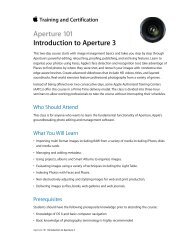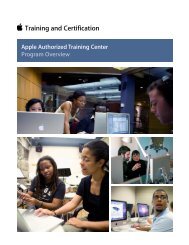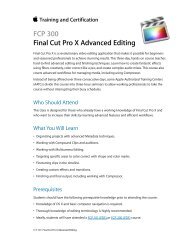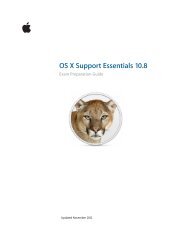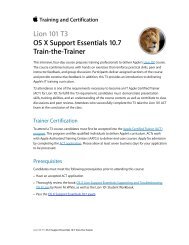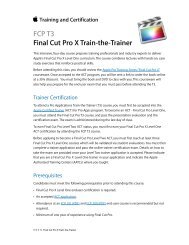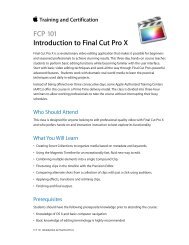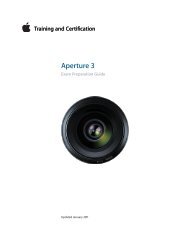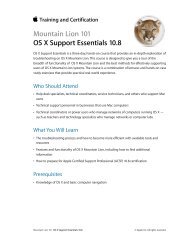Final Cut Pro X - Training and Certification - Apple
Final Cut Pro X - Training and Certification - Apple
Final Cut Pro X - Training and Certification - Apple
Create successful ePaper yourself
Turn your PDF publications into a flip-book with our unique Google optimized e-Paper software.
<strong>Final</strong> <strong>Cut</strong> <strong>Pro</strong> X Level One <strong>and</strong> Associate-Level Exam Preparation Guide<br />
2. To create an edit, click an edit button in the toolbar; choose<br />
an editing comm<strong>and</strong> from the Edit menu, such as Append;<br />
press a keyboard shortcut; drag a clip from the Event<br />
Browser, from a media browser such as the Photos Browser, or<br />
from the Finder.<br />
3. An append edit adds one or more clips to the end of a<br />
project or storyline. insertion<br />
4. Press Comm<strong>and</strong>-= (equal sign) to zoom in, <strong>and</strong> press<br />
Comm<strong>and</strong>-– (minus sign) to zoom out. You can also zoom in<br />
<strong>and</strong> out by dragging the Zoom control in the lower right of<br />
the Timeline.<br />
5. Click the Clip Appearance button in the lower-right corner of<br />
the Timeline. In the Clip Appearance window, drag the Clip<br />
Height slider to the left to decrease the clip height, or to the<br />
right to increase the clip height.<br />
6. In the lower-left corner of the Timeline, click the Timeline<br />
Index button, or press Comm<strong>and</strong>-Shift-2. The Timeline Index<br />
pane appears to the left of the Timeline <strong>and</strong> displays clips <strong>and</strong><br />
tags (such as keywords) used in the current project in their<br />
order of appearance.<br />
7. Position your pointer over the volume line in the Timeline.<br />
When the pointer turns into a vertical resize pointer, drag<br />
down to lower the volume or drag up to raise it. To facilitate<br />
your adjustments, turn on audio waveforms in the Clip<br />
Appearance window. Audio that approaches peak levels<br />
appears yellow in the waveform; audio that exceeds peak<br />
levels appears red.<br />
8. Select the clip in the Timeline, click the Inspector button in<br />
the toolbar, <strong>and</strong> then click the Audio tab <strong>and</strong> deselect the<br />
appropriate tracks.<br />
9. You would select this option when you want to copy the<br />
project <strong>and</strong> all of the source clips in the associated Events to<br />
another hard disk.<br />
10. Click the Snapping button in the Timeline, press N, or choose<br />
View > Snapping.<br />
11. A blue insertion line indicates where clips will be placed.<br />
12. Position the playhead in the Timeline where you want to<br />
connect one or more clips. Select the clips in the Event<br />
Browser. In the toolbar, click the Connect button, or press Q. A<br />
blue insertion line in the Timeline indicates the connection<br />
point.<br />
17



